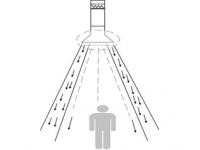Electroactive Smart Air-Conditioner VEnt Registers (eSAVER)

Technology Description:
Stony Brook University will develop eSAVER, an active air conditioning vent capable of modulating airflow distribution, velocity, and temperature to promote localized thermal envelopes around building occupants. Stony Brook’s smart vent modulates the airflow using an array of electro-active polymer tubes that are individually controlled to create a localized curtain of air to suit the occupant’s heating or cooling needs. The eSAVER can immediately be implemented by simply replacing an existing HVAC register with the new unit or can be installed in new constructions for significant reduction in HVAC system size,construction cost,and further improvement in energy efficiency.The project team estimates this will result in upwards of 30% energy savings through directed localization of existing building heating/cooling output.
Potential Impact:
If successful, DELTA technology could increase energy efficiency, reduce emissions produced by powering traditional HVAC systems, and enable more sustainable heating and cooling architectures for energy-efficient building design.
Security:
The innovations developed under the DELTA program have the potential to increase energy efficiency, improve overall building performance, and reduce HVAC energy consumption by at least 15%.
Environment:
The heating and cooling of buildings generates about 13% of the U.S. domestic greenhouse gas emissions. Through improved utilization of energy produced by fossil fuels with full adoption DELTA can reduce these emission by 2%.
Economy:
DELTA program innovations can help U.S. businesses eventually reduce reliance on tightly controlled building environments, thus enabling radical and sustainable architecture in next generation energy efficient building designs.
Contact
ARPA-E Program Director:
Dr. Jennifer Gerbi
Project Contact:
Dr. Ya Wang
Press and General Inquiries Email:
ARPA-E-Comms@hq.doe.gov
Project Contact Email:
ya.s.wang@stonybrook.edu
Partners
NxEco, Inc
Polyradiant Corp.
University of California, Los Angeles
Related Projects
Release Date:
04/29/2014
